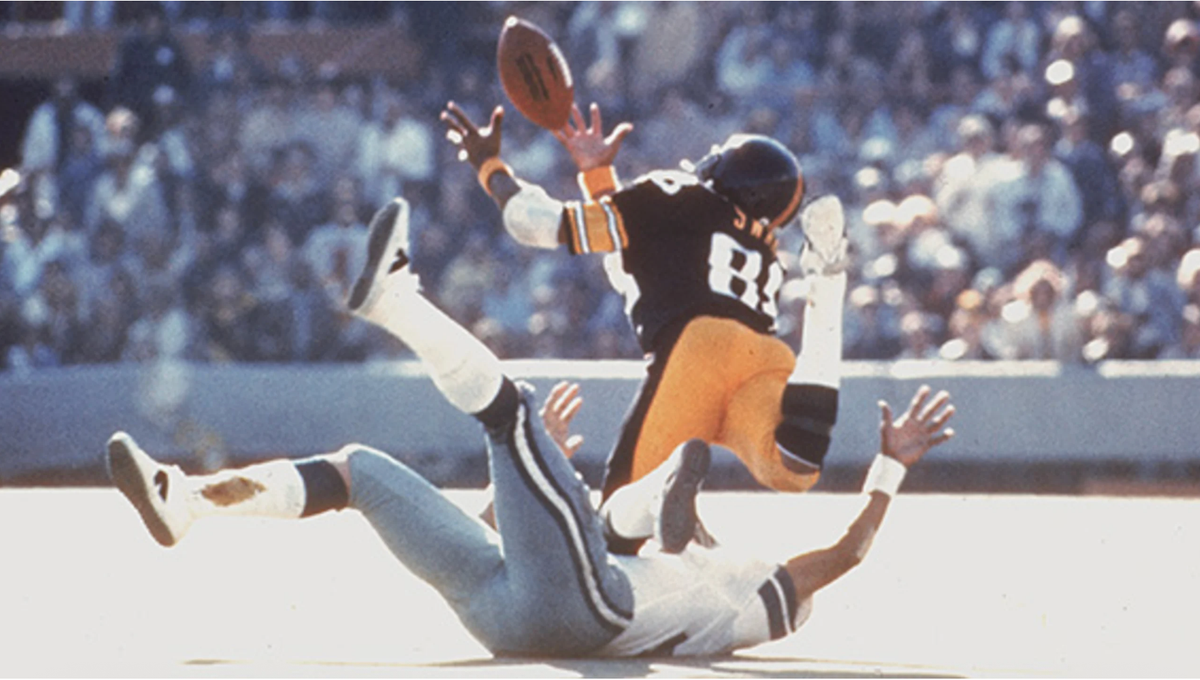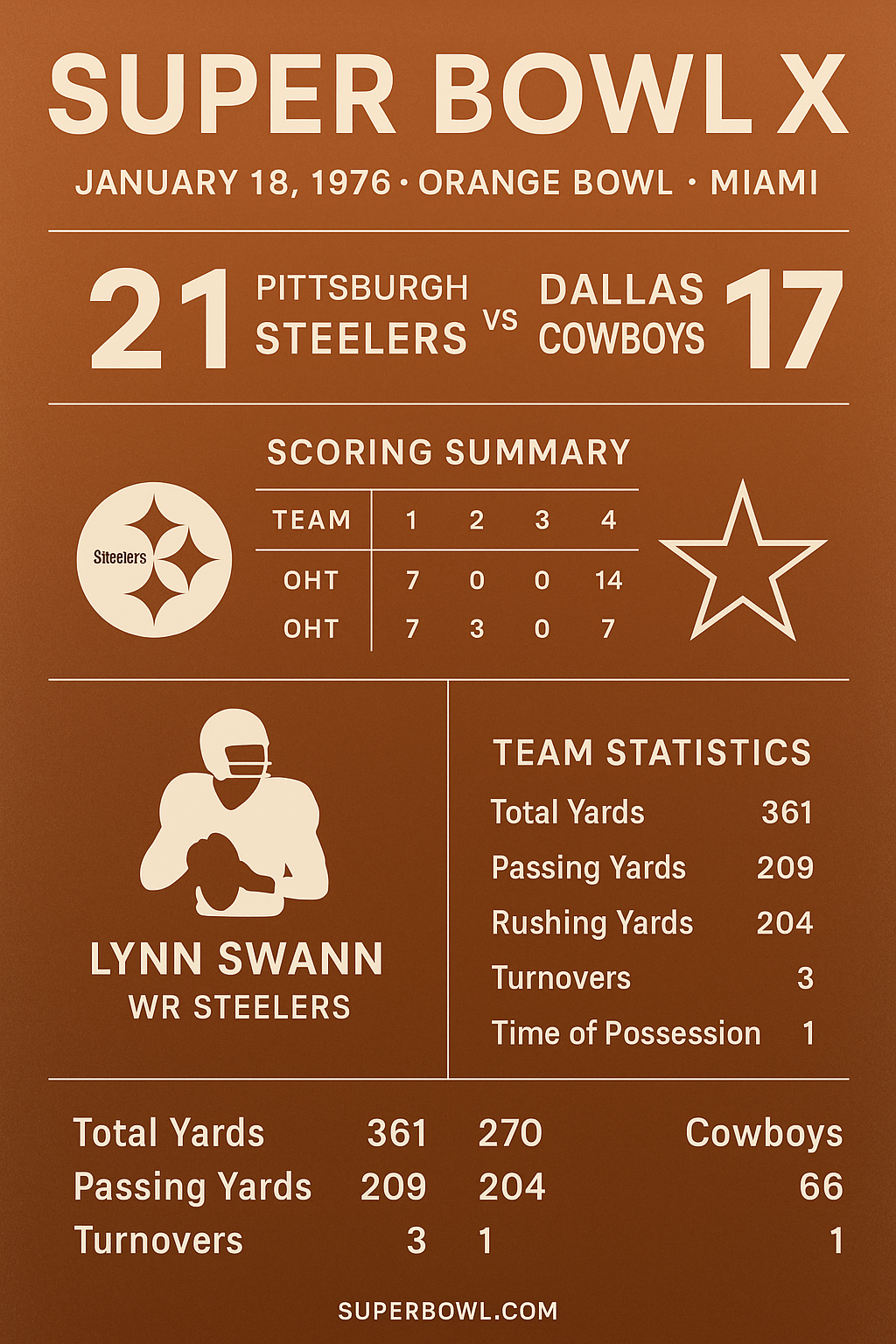Super Bowl X: The Steelers Repeat and the Dynasty Solidifies

On January 18, 1976, the Pittsburgh Steelers defended their title in thrilling fashion, defeating the Dallas Cowboys 21–17 in Super Bowl X at the Orange Bowl in Miami. In a dramatic clash between two of the NFL’s most iconic franchises, this Super Bowl delivered everything fans could hope for—momentum swings, legendary performances, and a final quarter packed with intensity.
Super Bowl X wasn’t just the Steelers’ second championship—it was the moment their dynasty was defined. With a resilient quarterback in Terry Bradshaw, a swarming defense led by the Steel Curtain, and a receiver who turned in one of the greatest performances in Super Bowl history, Pittsburgh proved they were the NFL’s gold standard.
I. Pre-Game Narrative: Clash of Powerhouses
The Steelers entered the game at 12–2, having dispatched the Colts and Raiders in the playoffs. Led by head coach Chuck Noll, they were known for their physical brand of football, defined by dominant line play, a bruising run game with Franco Harris, and a ferocious defense.
The Cowboys, coached by the brilliant and stoic Tom Landry, had finished 10–4. Their high-powered offense, nicknamed the “Flex” offense, was led by quarterback Roger Staubach, explosive wide receiver Drew Pearson, and do-it-all running back Robert Newhouse. Their defense—featuring Harvey Martin, Ed “Too Tall” Jones, and Cliff Harris—was opportunistic and fast.
This was the first Super Bowl between two wild card teams, and it marked the beginning of a legendary rivalry.

II. Game Flow: A Tug of War in the Sunshine
First Half: Dallas Seizes Control
Dallas struck first. In the first quarter, Staubach hit Drew Pearson for a 29-yard touchdown, capping a crisp 5-play, 80-yard drive. After a Roy Gerela missed field goal, Dallas extended their lead to 10–7 in the second quarter following a Toni Fritsch field goal.
Pittsburgh struggled to find rhythm early. Gerela missed another field goal, and Bradshaw was under constant pressure. However, the Steelers stayed alive thanks to a Frank Lewis touchdown reception, tying the score at 7–7 in the second quarter.
The Cowboys went into halftime with a slim 10–7 lead.
III. Lynn Swann’s Historic Game
The standout performance of the day belonged to wide receiver Lynn Swann, who finished with 4 catches for 161 yards and a touchdown, becoming the first wide receiver named Super Bowl MVP.
Swann’s performance was nothing short of spectacular:
- A 53-yard leaping grab in the first half showed his balletic grace.
- A 64-yard reception on a third-quarter drive helped flip field position.
- A clinching 64-yard touchdown in the fourth quarter became one of the most replayed highlights in Super Bowl history.
SuperBowl.com analyst Gina Atwell commented:
“Swann turned poetry into points. In a game full of iron and grit, he brought elegance—and won the war.”
His artistry—set against the physical brutality of the game—became symbolic of Pittsburgh’s balance: power and polish.
IV. Fourth Quarter Madness
With the score 10–7 entering the fourth, the game reached legendary status:
- Pittsburgh took the lead with a Gerela field goal and a safety, making it 12–10.
- Bradshaw then launched a perfect 64-yard bomb to Swann to go up 21–10.
- With just 1:22 left, Staubach responded, leading a quick touchdown drive capped by a pass to Percy Howard, cutting it to 21–17.
- The Cowboys recovered the onside kick—but were stopped by the Steel Curtain defense in the final seconds.
The last five minutes of the game remain among the most dramatic in Super Bowl history.
V. Bradshaw’s Toughness
Though he threw for just 209 yards on 9 completions, Terry Bradshaw delivered when it mattered. The bomb to Swann was a pivotal moment—and he paid for it, taking a brutal hit from Larry Cole just as he released the ball.
He left the game briefly, but his toughness and leadership became a rallying point for the team. Backup Mike Kruczek was ready but never needed. Bradshaw’s ability to weather pressure, trust his receivers, and play through pain solidified his growing reputation as a clutch performer.
VI. The Steel Curtain Delivers Again
Pittsburgh’s defense was outstanding, holding the Cowboys to just 17 points, despite three turnovers by the Steelers.
- Jack Lambert led the charge with 14 tackles and his infamous takedown of Cliff Harris after Harris taunted Gerela following a missed kick.
- Joe Greene and L.C. Greenwood pressured Staubach all game, with Greenwood batting down three passes.
- The secondary, led by Mel Blount, limited Dallas’s deep threats for most of the contest.
SuperBowl.com analyst Kendrick Hayes summed it up:
“You don’t measure the Steel Curtain in stats—you measure it in fear. They didn’t just beat offenses, they broke them.”
VII. Key Stats
| Category | Steelers | Cowboys |
|---|---|---|
| Total Yards | 361 | 270 |
| Passing Yards | 209 | 204 |
| Rushing Yards | 122 | 66 |
| Turnovers | 3 | 1 |
| First Downs | 18 | 15 |
| Time of Possession | 34:41 | 25:19 |
The game was closer than the stats suggest. Turnovers and penalties (especially on Pittsburgh’s special teams) kept Dallas in it, but Pittsburgh controlled the line of scrimmage and the fourth quarter.
VIII. What This Win Meant
Super Bowl X was more than just a title defense. It marked Pittsburgh’s ascent to dynasty status. They became the third team (after Green Bay and Miami) to win back-to-back Super Bowls.
It also began the Steelers-Cowboys rivalry, which would be rekindled in Super Bowl XIII and XXX. This was the first time the Super Bowl felt like a cultural event—not just a game. America was watching two iconic franchises do battle with legacy on the line.
IX. Legacy Moments
- Swann’s MVP established him as one of the premier wide receivers of his era.
- Bradshaw’s toughness silenced doubters who still saw him as erratic or limited.
- Chuck Noll’s coaching continued to shine—his ability to adapt to game tempo, adjust playcalling, and trust his stars stood out.
For Dallas, the loss was crushing—but they would return, winning Super Bowl XII just two years later.
X. Cultural Footprint
Super Bowl X solidified the Super Bowl as a national holiday. With a thrilling finish, big plays, and a sense of drama, it laid the groundwork for the high-stakes, high-drama standard the event has maintained ever since.
- TV viewership peaked at over 58 million.
- The halftime show, broadcast enhancements, and celebrity presence grew.
- NFL Films immortalized the game with dramatic slow-motion footage of Swann’s catches.
XI. Final Thoughts: The Steel Is Forged
Pittsburgh’s win in Super Bowl X wasn’t just about points—it was about identity. They showed they could win ugly (as in Super Bowl IX) and now they proved they could win with drama, flair, and big plays.
Swann’s catches. Bradshaw’s grit. Lambert’s fury. It was all there.
And with that, the Steelers etched their place in history—not just as champions, but as a dynasty that defined an era.
